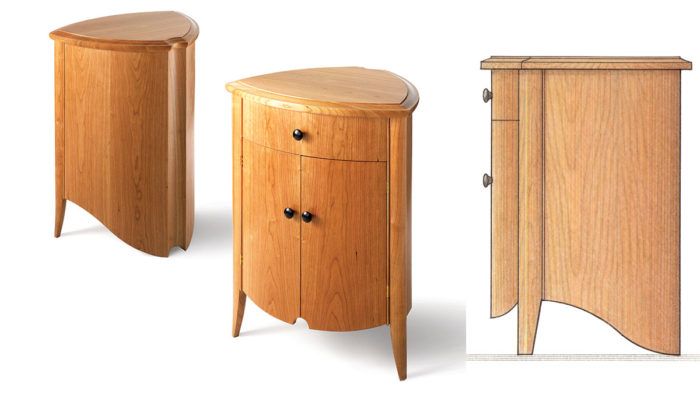Inspiration for a Bedside Cabinet
Subtle details complement form and function
Synopsis: Michael Fortune got the inspiration for his curved bedside cabinet from a flea-market find in his college days. His old pine chest of drawers had back legs that were cut out extensions of the solid-wood side panels. This simple leg-curve design came into play when Fortune designed his bedside cabinet, which also includes a wide cove from top to bottom along the back, a bead detail that cleverly conceals the hinges of the cabinet doors, and a drawer with curved front and sides.
When designing a piece of furniture, I never know where an idea is going to come from. Indeed, it sometimes evolves quietly from an unlikely place. That certainly was the case when I designed this bedside cabinet.
During my college days, my apartment had virtually no furniture. One day, however, I had the good fortune to find an old pine chest of drawers in a ditch by the side of the road. I hauled the piece back to my apartment, all the while anticipating the luxury of getting my clothes off the floor.
I figured the chest to be about 200 years old. It was apparent that the builder was both clever and expeditious, as evidenced by back legs that simply were cut out of solid-wood side panels. I ended up living with that chest for 35 years. During that time, I came to appreciate the brilliance of the simple back-leg design. And when I began to design this bedside cabinet, I included the leg curve from that wonderful old chest.
The bedside cabinet also includes a wide cove that runs top to bottom along the back. Initially, it was to serve as a channel for cords from a lamp and an alarm clock. But some rough sketches I made, followed by more detailed drawings, revealed that the cove also introduced an interesting rhythm to the back surfaces of the form.
I included the semicircular cutout detail on the bottom of the doors to draw attention to the space under the cabinet. The door cutout also complements the cove at the back of the cabinet.
I wanted to avoid using European-style concealed hinges for the door. Although you can’t see these hinges when the doors are closed, European hinges become very visible once a door is opened. I thought the mechanism would look too big on a somewhat smallish piece. I solved the problem by incorporating a bead detail on both sides of the front legs. Then I put two butt hinges within each bead. As a result, the barrel of the hinge simply becomes part of the bead detail. First, though, I had to find a hinge with the appropriate thickness, and then I sized the bead to match the barrel of the hinge.
From Fine Woodworking #171
For the full article, download the PDF below.
Fine Woodworking Recommended Products

Drafting Tools

Stanley Powerlock 16-ft. tape measure

Drafting Tools






















Log in or create an account to post a comment.
Sign up Log in